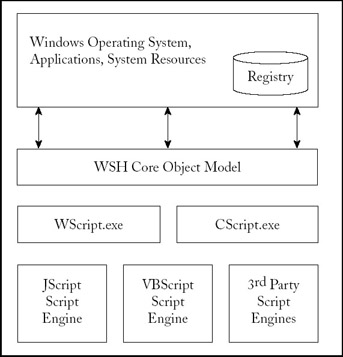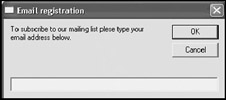Introducing the WSH
Administrators with a previous background in JavaScript or Visual Basic programming will find the WSH easier to learn than nonprogrammers. The WSH is shipped with two built-in scripting languages, JScript and VBScript. JScript is Microsoft implementation of JavaScript, and VBScript is a scripting version of the Visual Basic language. Both JScript and VBScript have their origins in Web development but have been modified by Microsoft to allow them to function outside of the Internet Web browser.
The Advantages of Using the WSH
The WSH can often be used to develop scripts that cannot be written using Shell scripting. For example, Shell scripts cannot directly access the Windows XP registry, whereas the WSH object model allows WSH scripts to read, change, and delete registry keys and values. In addition, the WSH has more advanced file and folder administration capabilities. While Windows Shell scripting can script many Windows tasks, the more complex the task becomes, the more likely that the WSH is the better scripting language to use.
The WSH offers several capabilities not provided by Shell scripting, including:
-
The ability to display and collect user input using pop-up dialogs
-
The ability to run on all Windows operating systems since Windows 95, making WSH scripts more portable
-
The ability to manipulate the Windows desktop, taskbar, and toolbars
-
The ability to work directly with Windows applications by accessing their object models
Examining the WSH Architecture
The WSH is a 32-bit Windows application. It is made up of a number of separate components, each of which performs a specific function. These components include:
-
A core object model
-
Two execution environments
-
Two scripting engines
These three sets of components fit together as shown in Figure 14.1.

Figure 14.1: The WSH is made up of a number of separate components
The WSH core object model provides access to Windows objects, allowing direct control over a number of Windows XP resources such as the registry, desktop, file system, and network resources. Each object exposed by the core object model has associated methods and properties that WSH scripts can execute or modify. WSH scripts require an execution host to provide an environment in which they can execute. The WSH supplies two execution hosts, as listed below.
-
CScript.exe. Supports text-based scripts that run in command-line mode and is usually used to run scripts that execute in the background and require no user interaction.
-
WScript.exe. Provides the ability to run WSH scripts that communicate with the user using pop-up graphical dialogs.
Figures 14.2 and 14.3 demonstrate the WSH WScript execution host support for pop-up dialogs. This capability allows administrators to write scripts that are more user-friendly.

Figure 14.2: A GUI pop-up dialog that prompts the user to select a response

Figure 14.3: A GUI pop-up dialog that allows the user to provide text input
Aside from WScript's support for pop-up dialogs, the CScript and WScript execution hosts provide identical functionality.
WSH execution environments depend on script execution engines to process and interpret scripts statements. The WSH ships with two scripting engines, one for JScript and one for VBScript. Each of these scripting engines is specifically designed to interpret scripting statements particular to its defined language.
| Note | To learn more about the WSH, JScript, and VBScript, refer to the Microsoft Windows Scripting Technologies Web site at http://msdn.microsoft.com/scripting. |
Working with JScript and VBScript
WSH script files are created using a particular scripting language and are then saved using a file extension appropriate for that language. For example, WSH scripts written in JScript are saved as plain text files with a .js file extension. WSH scripts written in VBScript are saved with a .vbs file extension.
| Note | Third-party software developers have created WSH-compatible scripting languages for Perl and Python. |
When writing scripts in JScript or VBScript, administrators must be careful to closely follow the specific rules and syntax for each scripting language. Despite very different origins, JScript and VBScript provide equivalent scripting capabilities. JScript will be easier to learn for administrators with JavaScript experience, whereas VBScript will be easier to learn for administrators with Visual Basic programming experience.
The WSH also provides the ability to combine more than one scripting language into a single script file known as a WSF (Windows Script File) with a .wsf file extension. WSFs use a subset of the XML (Extensible Markup Language) to format WSF scripts and to identify which portions of the script are written in JScript and which portions are written in VBScript.
| Note | Administrators interested in gaining advanced knowledge of the WSH should read Microsoft Windows Shell Scripting and WSH Administrator's Guide by Jerry Lee Ford Jr., published by Premier Press, 2001. For more information about VBScript, read Learn VBScript in a Weekend by Jerry Lee Ford Jr., published by Premier Press, 2002. For more information about JavaScript and JScript, read Learn JavaScript in a Weekend by Jerry Lee Ford Jr., published by Premier Press, 2001. |
EAN: 2147483647
Pages: 358
- ERP Systems Impact on Organizations
- The Effects of an Enterprise Resource Planning System (ERP) Implementation on Job Characteristics – A Study using the Hackman and Oldham Job Characteristics Model
- Distributed Data Warehouse for Geo-spatial Services
- A Hybrid Clustering Technique to Improve Patient Data Quality
- Relevance and Micro-Relevance for the Professional as Determinants of IT-Diffusion and IT-Use in Healthcare
- An Emerging Strategy for E-Business IT Governance
- A View on Knowledge Management: Utilizing a Balanced Scorecard Methodology for Analyzing Knowledge Metrics
- Technical Issues Related to IT Governance Tactics: Product Metrics, Measurements and Process Control
- Governing Information Technology Through COBIT
- The Evolution of IT Governance at NB Power